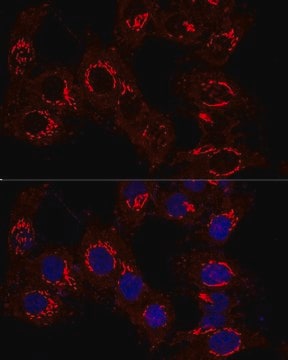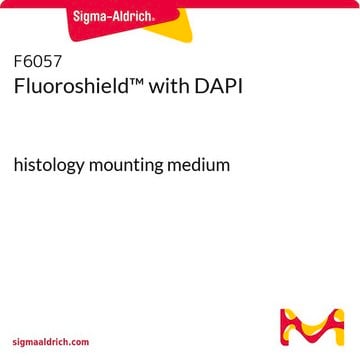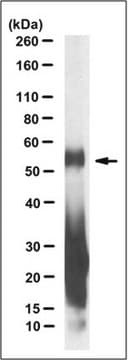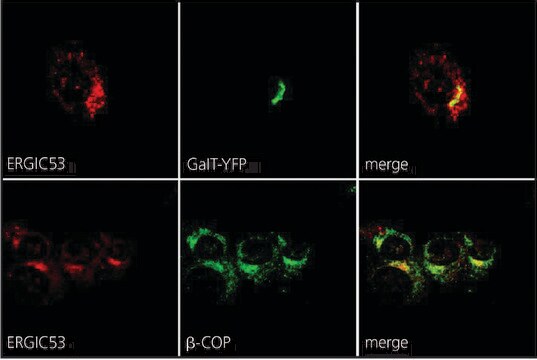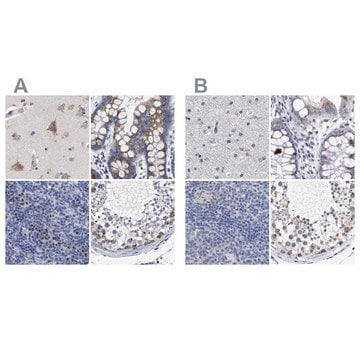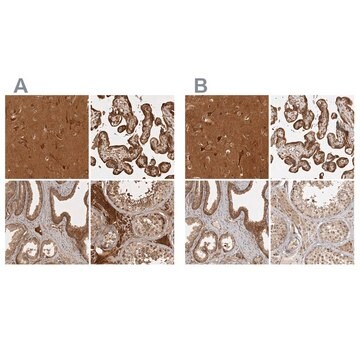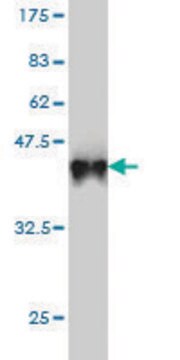G7295
Anti-GM130 (C-terminal) antibody produced in rabbit
affinity isolated antibody, buffered aqueous solution
Sinónimos:
Anti-GM130 (Golgi Matrix Protein of 130 kDa), Anti-Golgi Autoantigen, Anti-Golgi Matrix Protein GM 130
Seleccione un Tamaño
688,00 €
Seleccione un Tamaño
About This Item
688,00 €
Productos recomendados
origen biológico
rabbit
Nivel de calidad
conjugado
unconjugated
forma del anticuerpo
affinity isolated antibody
tipo de anticuerpo
primary antibodies
clon
polyclonal
Formulario
buffered aqueous solution
mol peso
antigen ~130 kDa
reactividad de especies
mouse, human, rat
técnicas
immunoprecipitation (IP): 2-4 μg using Hela and 3T3 cell extracts.
indirect immunofluorescence: 0.2-0.4 μg/mL using rat NRK cells
western blot (chemiluminescent): 0.1-0.2 μg/mL using whole extract of rat NRK cells
Nº de acceso UniProt
Condiciones de envío
dry ice
temp. de almacenamiento
−20°C
modificación del objetivo postraduccional
unmodified
Información sobre el gen
human ... GOLGA2(2801)
mouse ... Golga2(99412)
rat ... Golga2(64528)
Categorías relacionadas
Descripción general
Inmunógeno
Aplicación
- immunoblotting
- indirect immunofluorescence[1]
- immunoprecipitation
- immunohistochemistry
Immunohistochemistry (1 paper)
Western Blotting (1 paper)
Acciones bioquímicas o fisiológicas
Forma física
Cláusula de descargo de responsabilidad
¿No encuentra el producto adecuado?
Pruebe nuestro Herramienta de selección de productos.
Producto relacionado
Código de clase de almacenamiento
10 - Combustible liquids
Clase de riesgo para el agua (WGK)
WGK 3
Punto de inflamabilidad (°F)
Not applicable
Punto de inflamabilidad (°C)
Not applicable
Elija entre una de las versiones más recientes:
Certificados de análisis (COA)
¿No ve la versión correcta?
Si necesita una versión concreta, puede buscar un certificado específico por el número de lote.
¿Ya tiene este producto?
Encuentre la documentación para los productos que ha comprado recientemente en la Biblioteca de documentos.
Los clientes también vieron
Artículos
Centrifugation separates organelles based on size, shape, and density, facilitating subcellular fractionation across various samples.
Filtros activos
Nuestro equipo de científicos tiene experiencia en todas las áreas de investigación: Ciencias de la vida, Ciencia de los materiales, Síntesis química, Cromatografía, Analítica y muchas otras.
Póngase en contacto con el Servicio técnico
